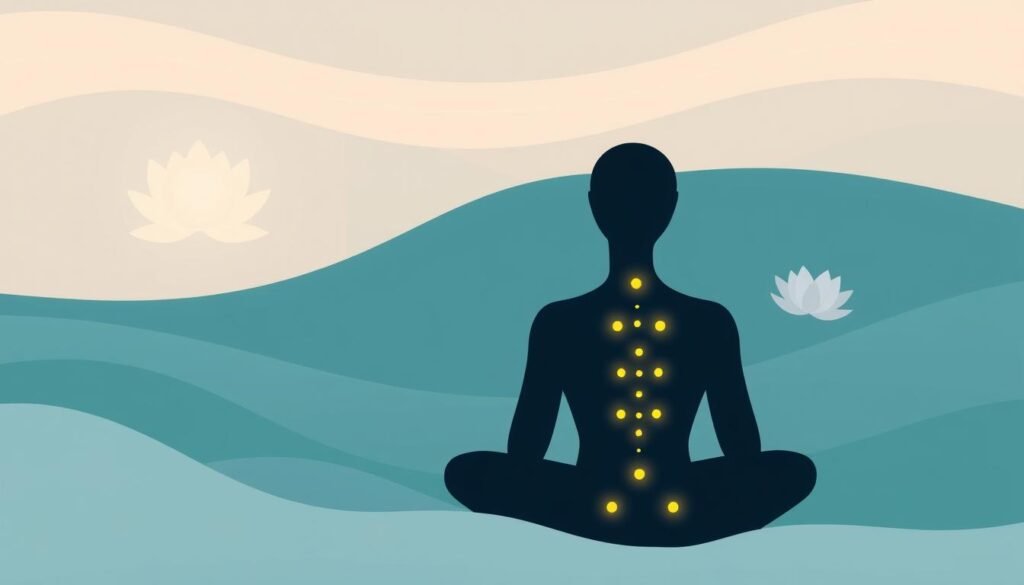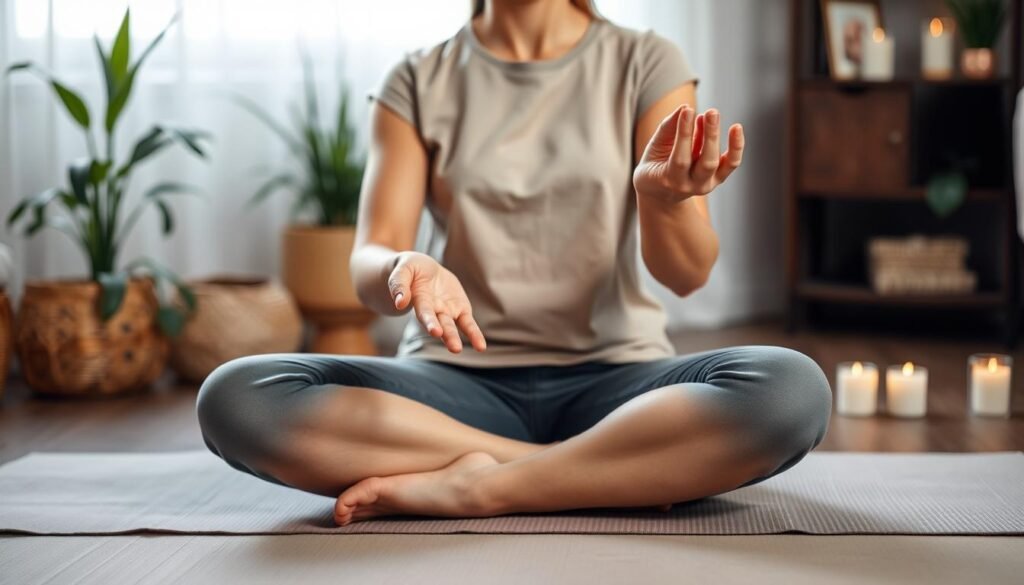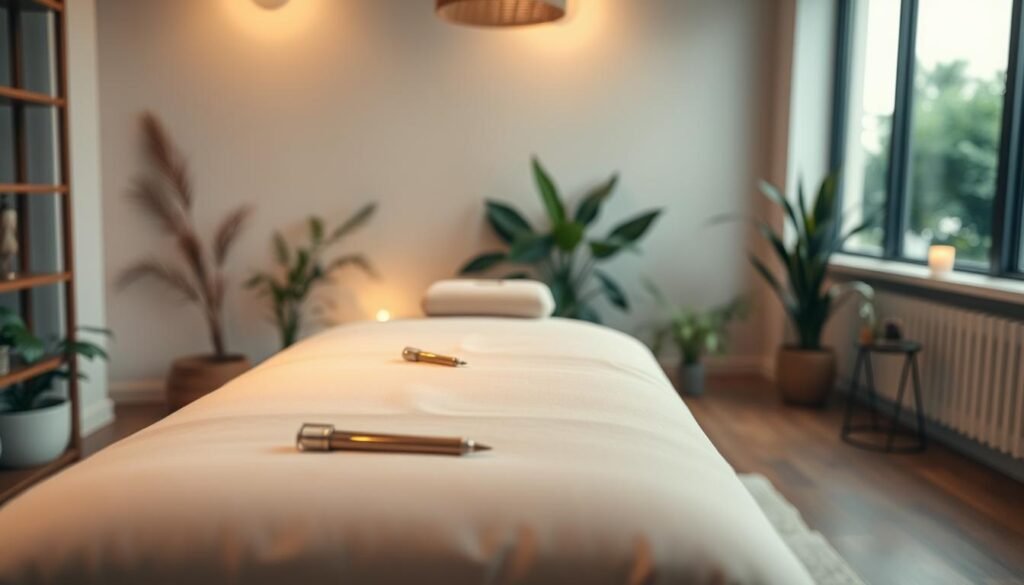Over 40 million adults in the U.S. battle anxiety each year. This high number shows we need ways to ease anxiety that people can easily use. Acupressure, from Traditional Chinese Medicine, has been helping for hundreds of years. It reduces stress, pain, and anxiety without needing modern medicine.
Acupressure works by pressing certain points on the body. It’s a simple method that doesn’t involve needles, unlike acupuncture. You can even do it yourself at home for fast stress relief. Studies say that touching these special points can make you feel more relaxed. It can give quick relief from the tough moments anxiety brings. By knowing acupressure points for anxiety, you can start feeling better on your own.
Next, we’ll look at how certain points on the body can lessen anxiety and stress. We’ll also talk about ways to care for yourself effectively. This journey into acupressure could be your key to handling the hard times anxiety causes.
Key Takeaways
- Over 40 million adults in the U.S. face anxiety disorders every year.
- Acupressure has been used for centuries to promote relaxation and stress relief.
- This needle-free technique offers a simple way to manage anxiety at home.
- Specific acupressure points can significantly reduce anxiety symptoms when targeted effectively.
- Research indicates acupressure is a valuable complementary therapy alongside other treatments.
Introduction to Acupressure and Anxiety
Acupressure is an intriguing method used in traditional Chinese medicine. It focuses on pressing specific pressure points to reduce stress and bring balance back. It’s particularly useful for managing anxiety, which causes intense worry and fear. These feelings can interfere with someone’s happiness. Using acupressure for stress can improve emotional health.
Many studies have shown that acupressure helps relieve anxiety for a while. Certain spots like the Shen Men Ear Point and Tai Chong (Liver 3) address both emotional and physical sides of anxiety. The Nei Guan (Pericardium 6) point, found about 1.5 inches above the wrist, is really good for reducing irritability and improving sleep.
Acupressure is flexible and can be used for different anxiety types defined in Chinese medicine. For “Excess” anxiety, pressing on “The Four Gates” points often helps. And for “Deficient” anxiety, points like P-6 and Ren-6 aid in fighting fear and fatigue. This method is a holistic way to tackle anxiety.
There are experts and materials available to teach acupressure use in daily life. Looking into holistic anxiety solutions adds more tools for those struggling with anxiety.
Understanding Anxiety and Its Impact
Anxiety can show up in many ways. You might feel restless, tired, or easily annoyed. These issues can interfere with everyday life, harming job performance and relationships. It’s key to understand how anxiety affects well-being.
People with anxiety often find it hard to concentrate. This can make them less productive at work. Their relationships might struggle too, as they become irritable or pull away from others. If anxiety isn’t managed, it can lead to bigger mental health problems.
Physical symptoms like tense muscles and sleep problems can also occur. These issues can make anxiety worse. Recognizing these signs helps in finding coping methods. Techniques such as acupressure might help. They not only ease the discomfort but also help in achieving a balanced lifestyle.
| Impact of Anxiety | Positive Measures |
|---|---|
| Decreased productivity at work | Incorporating anxiety relief techniques |
| Strained relationships | Seeking support from loved ones |
| Physical symptoms (e.g., tension, sleep issues) | Practicing stress-reduction methods |
| Increased irritability | Engaging in mindfulness exercises |
What is Acupressure?
Acupressure is an age-old practice from Traditional Chinese Medicine. It uses pressure point therapy to boost well-being, ease ailments, and bring relaxation. This method believes our body has special points connected to energy paths, or meridians. Pressing these points can help the energy, called qi, flow better. This can help solve different physical and mental issues.
The History of Acupressure and Traditional Chinese Medicine
Acupressure has been key in Traditional Chinese Medicine, evolving with acupuncture. It’s been used to solve many health issues, tapping into the body’s energy systems. It’s known for easing symptoms like anxiety and stress by pressing specific points.
How Acupressure Differs from Acupuncture
Acupressure and acupuncture share the same roots but use different methods. Acupuncture uses needles at acupoints, while acupressure uses finger pressure. This makes acupressure easier for self-care, offering instant relief at home. Thus, it’s a popular choice for those looking to reduce anxiety and stress on their own.
Benefits of Acupressure for Anxiety Relief
Acupressure has many benefits for easing anxiety. It gives quick relief but should go hand in hand with therapy or meds for best results. Using special acupressure points can relax the nervous system fast.
Temporary Relief versus Long-term Solutions
Acupressure is great for quick stress relief. For example, patients feel less anxious during medical procedures thanks to it. But, it’s not a stand-alone solution for ongoing anxiety. Combining it with professional advice makes for a stronger way to tackle anxiety.
Complementary Therapy for Holistic Treatment
Acupressure is part of a bigger health picture. It promotes emotional well-being and eases stress. Certain points like the Heavenly Gate help with sleep troubles and pain. Together, these practices lead to a balanced lifestyle, fighting anxiety now and later. For tips on acupressure methods, click here.

Acupressure Points for Anxiety
Acupressure is a great way to ease anxiety. It uses specific points that calm you down. Stimulating these points can help manage emotions and lessen tension. Below are six important points.
Hall of Impression Point
The Hall of Impression point is right between the eyebrows. It’s great for lowering stress and easing anxiety.
Heavenly Gate Point
The Heavenly Gate point is located at the top part of the ear. It’s known for reducing anxiety and helping with sleep problems. It brings a feeling of calm.
Shoulder Well Point
This point can be found in the shoulder muscle. It’s key for releasing stress and tension that we carry every day.
Union Valley Point
Located between the thumb and the first finger, the Union Valley point helps a lot. It eases stress and can make headaches better.
Great Surge Point
You can find the Great Surge point on your foot. It’s not just for anxiety relief. It also helps manage pain.
Inner Frontier Gate Point
The Inner Frontier Gate point is on the arm. It’s effective for fighting anxiety and reducing feelings of nausea.
How to Perform Acupressure at Home
Using acupressure at home can help manage stress and worry. It’s important to do it right to get its full benefits. This includes finding the correct acupoints, applying pressure properly, and making sure you’re comfortable.
Finding the Right Acupoints
For successful acupressure, find specific points known to ease anxiety. Key points include:
- DU 24: Between the eyebrows, helps with stress relief.
- Yintang: At the middle of the eyebrows, brings calmness.
- Taiyang: By the edge of the eyebrows, good for managing anxiety.
- Kidney 1: On the bottom of the foot, helps in feeling grounded and calm.
Techniques for Applying Pressure
Learning to apply acupressure involves several methods:
- Press gently but firmly with fingertips or knuckles.
- Stimulate acupoints with circular movements.
- Adjust the force to what feels good, keeping it pleasant.
Tips for Effective Self-Care with Acupressure
For the best results from acupressure, keep these tips in mind:
- Stay comfy in a quiet area for your practice.
- Focus on each point for 30 seconds to 2 minutes for effects.
- Use breathing methods to help relax, especially before sleeping.
- Be consistent; doing it regularly improves anxiety control.

Research on Acupressure for Stress Management
Recent studies have looked into acupressure for stress and anxiety. They show it could be very helpful for people dealing with stress. Researchers are digging deeper into this old method. The quest for strong proof is still on.
Review of Recent Studies and Findings
A study in Istanbul in 2020 focused on first-year nursing students. They were really stressed out. The students received acupressure at certain points on their bodies.
After three treatments, their stress levels had gone down significantly. Their average stress scores dropped from 6.95 to 2.82. This result points to acupressure as a potential way to ease anxiety.
Potential Limitations and Need for Further Research
The current research shows promise but also has its limits. Many studies have only a few people in them. Plus, the stress relief they found was often short-lived.
To get a clear picture of how well acupressure works, we need more research. It should involve more people and look at long-term results. This will help confirm how effective acupressure is for easing anxiety.
| Study Variables | Experimental Group | Control Group |
|---|---|---|
| Initial Stress Level (VAS Mean) | 6.95 ± 1.57 | N/A |
| Stress Level After 3 Applications (VAS Mean) | 2.82 ± 1.94 | N/A |
| Clinical Stress Score Before Treatment | 46.54 ± 3.81 | N/A |
| Clinical Stress Score After 3 Weeks | 25.15 ± 5.26 | N/A |
| Acupressure Points Used | HT7, Yintang (EX-HN3) | N/A |
Combining Acupressure with Other Anxiety Relief Techniques
Managing anxiety involves different strategies. Using acupressure with other anxiety relief techniques makes treatment better. Acupressure works on certain points to help relax and improve energy flow. Studies reveal people feel less anxious when they add practices like mindfulness and meditation.
EFT tapping started in the 1990s. It’s an easy way to use acupressure points without spending much. Research shows it lowers heart rate and cortisol, proving its benefits. Mixing EFT with normal acupressure treatments tackles both emotional and physical sides of anxiety.
Regular exercise matters too. It boosts mood and fights anxiety by releasing endorphins. Pairing acupressure with working out improves overall health. Applying acupressure techniques after exercise aids in relaxation and recovery.
Using different methods to deal with anxiety works best. It lets people customize how they tackle anxiety. This approach supports mental health and leads to a more stable life.
When to Seek Professional Help
Knowing when to see a doctor for anxiety is key. While acupressure helps, recognizing when to get professional help is critical. Look out for signs that suggest it’s time for expert advice to maintain mental health.
Recognizing Severe Symptoms of Anxiety
Severe anxiety shows itself in many ways. It’s important to watch for any mental changes. Here are signs to be aware of:
- Frequent panic attacks, characterized by overwhelming fear and physical symptoms.
- Severe headaches that do not respond to typical over-the-counter medication.
- Persistent sleep disturbances, including insomnia or excessive sleepiness affecting daily activities.
- Inability to cope with daily routines, causing distress or affecting relationships.
Importance of Consulting Healthcare Providers
Seeing a doctor for serious anxiety is a step towards healing. Talking openly with experts helps explore treatment options, including therapy and medicine. This, along with acupressure, builds a full plan for better health. It’s comforting to know that professional help for anxiety complements self-care.
| Severe Symptoms | Recommended Action |
|---|---|
| Panic attacks | Consult a mental health professional for evaluation. |
| Severe headaches | Seek medical advice for appropriate diagnosis and treatment. |
| Sleep disturbances | Discuss with a healthcare provider regarding potential sleep disorders. |
| Inability to cope with daily routines | Explore therapy options with a licensed therapist. |
Safety Considerations While Practicing Acupressure
Safety in acupressure is key. This method brings benefits but also needs caution. Knowing the risks helps keep it safe and effective.
Who Should Avoid Acupressure?
Some people should be careful or skip acupressure. They should talk to doctors first:
- People with osteoporosis or fresh fractures.
- Individuals with bleeding disorders or on anticoagulant meds.
- Pregnant individuals, especially during certain trimesters.
- Those with uncontrolled high blood pressure or heart disease.
- Patients healing from surgeries or with cancer.
Precautions to Take During Practice
Follow these tips for a safe acupressure session:
- Press gently, especially around the face and belly.
- Skip areas with cuts, rashes, or infections.
- Keep the space clean to avoid infections.
- Start slow, limiting how long and often you do it.
- Listen to your body. Stop if it hurts or feels wrong.

Using these safety tips helps enjoy acupressure while lowering risks. Knowing the right approach ensures a safer experience.
| Group at Risk | Consultation Required |
|---|---|
| Osteoporosis Patients | Yes |
| Pregnant Individuals | Yes |
| People Taking Anticoagulants | Yes |
| Individuals with Bleeding Disorders | Yes |
| Those with Heart Disease | Yes |
Conclusion
Acupressure could be a great way to deal with anxiety. It shows promise in making people feel better without medication. Research has shown that acupressure helps lessen anxiety symptoms. This supports the idea that we should use many ways to improve our mental health.
If you’re looking for natural ways to manage anxiety, try acupressure. It focuses on certain points on the body to bring relaxation and better life quality. But, remember, for serious anxiety, keep getting professional help. The rise in mental health needs, especially with COVID-19, makes acupressure for anxiety relief an important option to consider.
Self-care is key in handling anxiety. It helps people take steps to improve their mental health. As the world changes, finding personal ways to manage stress is vital. Including acupressure might help you find more balance and peace.